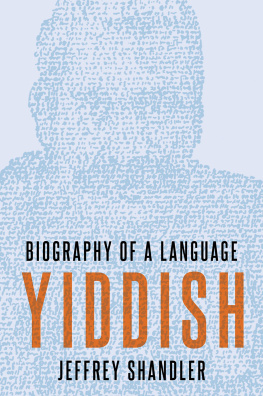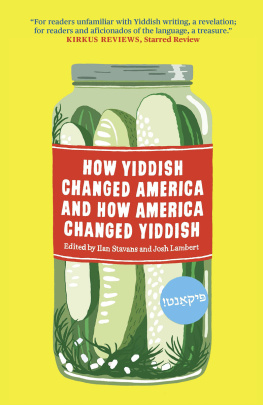Jeffrey Shandler - Yiddish: Biography of a Language
Here you can read online Jeffrey Shandler - Yiddish: Biography of a Language full text of the book (entire story) in english for free. Download pdf and epub, get meaning, cover and reviews about this ebook. year: 2020, publisher: Oxford University Press, USA, genre: Home and family. Description of the work, (preface) as well as reviews are available. Best literature library LitArk.com created for fans of good reading and offers a wide selection of genres:
Romance novel
Science fiction
Adventure
Detective
Science
History
Home and family
Prose
Art
Politics
Computer
Non-fiction
Religion
Business
Children
Humor
Choose a favorite category and find really read worthwhile books. Enjoy immersion in the world of imagination, feel the emotions of the characters or learn something new for yourself, make an fascinating discovery.
- Book:Yiddish: Biography of a Language
- Author:
- Publisher:Oxford University Press, USA
- Genre:
- Year:2020
- Rating:3 / 5
- Favourites:Add to favourites
- Your mark:
- 60
- 1
- 2
- 3
- 4
- 5
Yiddish: Biography of a Language: summary, description and annotation
We offer to read an annotation, description, summary or preface (depends on what the author of the book "Yiddish: Biography of a Language" wrote himself). If you haven't found the necessary information about the book — write in the comments, we will try to find it.
Yiddish: Biography of a Language — read online for free the complete book (whole text) full work
Below is the text of the book, divided by pages. System saving the place of the last page read, allows you to conveniently read the book "Yiddish: Biography of a Language" online for free, without having to search again every time where you left off. Put a bookmark, and you can go to the page where you finished reading at any time.
Font size:
Interval:
Bookmark:


Oxford University Press is a department of the University of Oxford. It furthers the Universitys objective of excellence in research, scholarship, and education by publishing worldwide. Oxford is a registered trade mark of Oxford University Press in the UK and certain other countries.
Published in the United States of America by Oxford University Press
198 Madison Avenue, New York, NY 10016, United States of America.
Jeffrey Shandler 2020
All rights reserved. No part of this publication may be reproduced, stored in a retrieval system, or transmitted, in any form or by any means, without the prior permission in writing of Oxford University Press, or as expressly permitted by law, by license, or under terms agreed with the appropriate reproduction rights organization. Inquiries concerning reproduction outside the scope of the above should be sent to the Rights Department, Oxford University Press, at the address above.
You must not circulate this work in any other form and you must impose this same condition on any acquirer.
Library of Congress Cataloging-in-Publication Data
Names: Shandler, Jeffrey, author.
Title: Yiddish : biography of a language / Jeffrey Shandler.
Description: New York : Oxford University Press, [2020] |
Includes bibliographical references and index.
Identifiers: LCCN 2020007938 (print) | LCCN 2020007939 (ebook) |
ISBN 9780190651961 (hardback) | ISBN 9780190651985 (epub) |
ISBN 9780190651992
Subjects: LCSH: Yiddish languageHistory.
Classification: LCC PJ5113 .S532 2020 (print) |
LCC PJ5113 (ebook) | DDC 439/.1dc23
LC record available at https://lccn.loc.gov/2020007938
LC ebook record available at https://lccn.loc.gov/2020007939
For Stuart
once more and ever more
I thank the School of Arts and Sciences at Rutgers University for providing me with a sabbatical and a fellowship leave, which were essential to completing the research and writing of this book. During this period, I benefited greatly from my term as a Harry Starr Fellow at the Center for Jewish Studies of Harvard University and am especially grateful for the thoughtful intellectual engagement I enjoyed with David Stern, director of the Center for Jewish Studies, and the other members of the fellowship group. And I am most thankful to my friends Emily Lichtenstein and John Minahan for their generous hospitality during my stay in Boston.
For their kind assistance during the course of my work on this book, I thank Zachary Baker, Ayala Fader, Zev Feldman, Raphael Finkel, Paul Glasser, Stefanie Halpern, Paul Hanebrink, Jordan Kutzik, Rafi Lehmann, James Masschaele, Michael Miller, Holger Nath, Anita Norich, Samuel Norich, Chaya Nove, Rebekah Pejsova-Klein, Derek Penslar, Eddy Portnoy, Alyssa Quint, Rukhl Schaechter, Gitl Schaechter-Viswanath, Naomi Seidman, and Vital Zajka.
My most heartfelt thanks go to Stuart Schear, my partner in life and intrepid fellow adventurer in Yiddishland.
Standard Yiddish, as established by the YIVO Institute for Jewish Research beginning in the 1930s, provides the basis for the Yiddish grammar, lexicon, orthography, and phonology presented in this book. All Yiddish terms are romanized, in italics, using the YIVO system and reflect Standard Yiddish pronunciation, except when demonstrating dialect variants. In some cases, accepted scholarly spellings of certain terms (e.g., Haskalah) are used and are not italicized. Romanizations of Yiddish that appear in citations preserve their sources spellings.
Some Yiddish terms also appear in this book in the Jewish alphabet (i.e., the alef-beys) when this is relevant to the discussion. Except where noted, these terms are spelled according to YIVO Standard orthography, and they are also romanized. Hebrew and Russian terms are romanized using the Library of Congress system, minus diacritics. Yiddish, Hebrew, and Russian names of people and organizations are romanized according to their own preferred spellings, when known (e.g., Sholem Asch, Bais Yaakov). When a preferred spelling is not known, an authoritative version (per the Library of Congress catalog or YIVO Encyclopedia of Jews in Eastern Europe) is used; otherwise, names are romanized according to one of the aforementioned systems.
Endnotes indicate when translations of cited works are by the author; otherwise, they are per the sources cited.
It is remarkable how often people have spoken about Yiddish as if it were a kind of person. They variously characterize the language as a mother, an orphan, a maidservant, a seductress, a deviant, a muse, a laborer, an invalid, a foreigner, a magician, even a ghost. What are the implications of this wide range of portrayals? How do they inspireand complicaterelating the story of Yiddish as the narrative of a human being, as a biography?
A biography of Yiddishor, for that matter, of any languageis an intellectually provocative concept. It anthropomorphizes something that, while not human, depends on humankind for its existence. Language is not only entirely the creation of humans (though religious traditions may teach otherwise) but also an attribute widely regarded as distinguishing humans from other beings. Moreover, language use figures extensively in differentiating among national, regional, ethnic, religious, class, gender, sexual, generational, educational, ideological, and professional groups. Therefore, approaching a language as the subject of a biography, a genre conventionally reserved for the study of an individual person, draws attention to the relationships of a language with its speakers and with the cultural practices that people realize in or in relation to the language.
These issues are especially fitting for a book about Yiddish, the foundational vernacular of Ashkenazic Jewry (that is, the diaspora Jewish people generally understood as originating in northern Europe). The language is closely identified with particular Ashkenazic populations, their activities, mores, convictions, and sensibilities. Moreover, the scope of discussions of Yiddish regularly expands to address the nature of these Jews and their cultural practices. This interrelation among people, language, and culture is a central concern for the study of Yiddish, as are its speakers complex internal diversity and their long, varied history of contact with speakers of other languages.
In order to probe both the possibilities and the challenges posed by the notion of a biography of a language, this book is not organized according to chronology, geography, activity, or ideology but instead offers a series of short thematic chapters that follow the rubric of a biographical profile: date and place of birth, family background, residence, and so on. Each chapter integrates an examination of some aspect of the development, form, or characteristics of Yiddish with part of the range and dynamics of the languages role in Ashkenazic life, from the Middle Ages to the present, and in locations on every continent where Yiddish speakers have settled. These chapters also probe the symbolic meanings that Jews and others have attributed to Yiddish over time, which are key to understanding the varied perceptions and valuations of the language. For example, the chapter Name both enumerates the different terms used over the centuries to identify the vernacular of Ashkenazic Jewry and considers what each name that people have given to the language now generally referred to as Yiddish reveals about their understandings of its use and its significance.
Font size:
Interval:
Bookmark:
Similar books «Yiddish: Biography of a Language»
Look at similar books to Yiddish: Biography of a Language. We have selected literature similar in name and meaning in the hope of providing readers with more options to find new, interesting, not yet read works.
Discussion, reviews of the book Yiddish: Biography of a Language and just readers' own opinions. Leave your comments, write what you think about the work, its meaning or the main characters. Specify what exactly you liked and what you didn't like, and why you think so.







